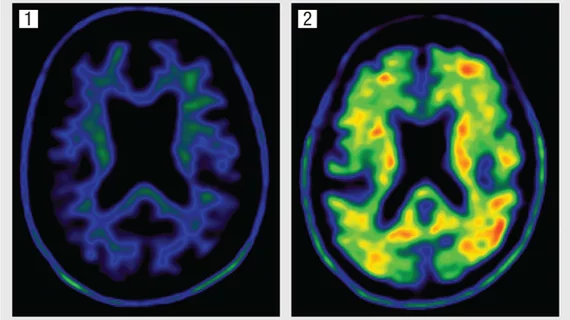Using an automated technique to quantify amyloid plaque on PET scans in a patient’s native space can improve the detection of brain amyloid buildup compared to traditional methods, according to a recent study published in the Journal of Nuclear Medicine.
The method may help track small amyloid changes in the brain and detect the protein in the preclinical phases of Alzheimer’s disease, reported first author Mouna Tahmi, MD, from Columbia University Medical Center’s Department of Neurology in New York, and colleagues.
Most automatic quantification methods use spatial normalization, the researchers explained, but numerous neuroimaging studies have revealed such methods aren’t completely accurate in measuring amyloid deposition, especially in older patients who have “significant brain atrophy even in the absence of age-related disease.”
“By circumventing the spatial normalization step and localizing tracer uptake within each subject’s brain independently, we propose a native space automatic quantification method that reduces the complexity of the between-subject warping problem to a within-subject rigid-body alignment,” Tahmi et al wrote.
All data used in their study was taken from a phase III 18F-Florbetaben PET imaging study performed from February 2010 to July 2013. In it, 52 older patients completed both 18F-Florbetaben PET and MR scans in-vivo before a post-mortem histopathological exam, which was used as the standard of truth (SOT) measurement. The team compared their technique to the conventional spatial normalization method.
Overall, the native space quantification method resulted in consistent and significantly higher standardized uptake value ratios (SUVRs) compared to the conventional technique in nearly every area of interest, the authors noted.
“Considering the histopathological assessment as the SOT for (amyloid) Aβ quantification, we show that the SUVR measurements obtained through the native space method are not only significantly higher than the ones obtained through the standard space method in almost all available brain regions and every histopathological staining level, but they are also significantly more predictive of the histopathological staining scores, suggesting higher precision of Aβ quantification,” Tahmi and colleagues wrote.
Additionally, the authors claim their method can be applied to current or future amyloid protein PET data for more accurate SUVRs, especially when tracking subtle changes in amyloid deposition during Alzheimer’s pathology.

